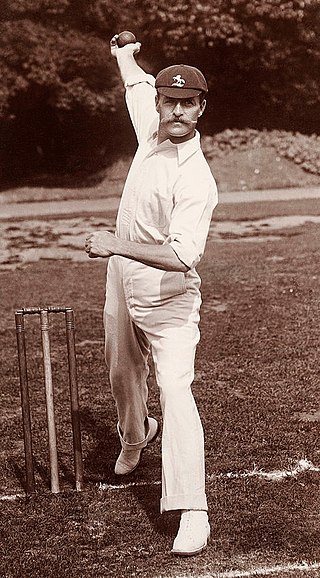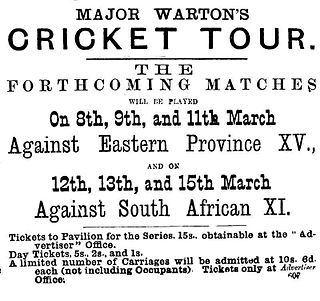Test matches in the 19th century were somewhat different affairs than what they are today. Many of them were not designated as Test matches for many years afterwards, and it is possible that some Test players never knew they had played in a Test. Before 1888 there had been 26 Test matches, all between England and Australia. England had won 13 of them, Australia 9, with 4 draws. During the 19th century England played in all the Tests, which were mostly against Australia, though a few were against what tended to be a very weak South African XI.
The history of Test cricket between 1884 and 1889 was one of English dominance over the Australians. England won every Test series that was played. The period also saw the first use of the word "Test" to describe a form of cricket when the Press used it in 1885. It has remained in common usage ever since.

Frank Hearne was an English born cricketer. One of the few men to play Test cricket for more than one country, he played for both England and South Africa. He was a member of the Hearne family of cricketers who played first-class cricket between 1879 and 1904 for Kent County Cricket Club and Western Province.

John James Ferris, a left-arm swing bowler, was one of the few cricketers to play Test cricket for more than one country.

William Chatterton was an English cricketer and footballer. He played first-class cricket for Derbyshire between 1882 and 1902 and for England on their tour of South Africa in 1891–92. He captained Derbyshire between 1887 and 1889 and scored over 10,000 runs in his first-class career as well as taking over 200 wickets. He played football for Derby County, being one of 19 sportsmen to achieve the Derbyshire Double of playing cricket for Derbyshire and football for Derby County.

Alec Hearne was a member of the famous cricketing Hearne family. He played as a professional for Kent County Cricket Club between 1884 and 1906 and made one Test match appearance for England. He was an all-rounder who was named as one of Wisden's five Cricketers of the Year in 1894. His father, George played cricket for Middlesex during the 1860s and brothers George and Frank also played Test cricket, as did his cousin, John Thomas Hearne.

George Gibbons Hearne was an English professional cricketer who played first-class cricket for Kent County Cricket Club between 1875 and 1895. He also played in one Test match for England against South Africa in 1891/92. Hearne was part of the famous cricketing Hearne family. His brothers Alec and Frank also played Test match cricket.
Ernest Austin "Barberton" Halliwell was a first-class cricketer, who played eight Test matches for South Africa between 1892 and 1902, including three as captain. He played as a wicket-keeper, and was the first to put raw steaks inside his gloves to protect his hands. At his peak, he was considered one of the best wicket-keepers in the world, and was named one of the Wisden Cricketers of the Year in 1905. He was particularly praised for standing close to the wickets, even against fast bowlers.
An England team toured Australia between November 1920 and March 1921. The tour was organised by the Marylebone Cricket Club and matches outside the Tests were played under the MCC name. The tour itinerary consisted of 13 first-class matches, including a series of 5 Test matches against Australia in which The Ashes were at stake.
This article describes the history of South African cricket from its known beginnings until the end of the First World War in 1918.

An English cricket team managed by Major R. G. Warton toured South Africa from December 1888 to March 1889. Warton was a retired British Army officer who had served on the general staff in Cape Town and was a member of the Western Province Cricket Club. He had been invited by local enthusiasts to bring a team of English first-class cricketers to the country. He negotiated with local agents called Billy Simkins and William Milton, who obtained sponsorship from Sir Donald Currie, founder of the Castle Shipping Line. They made all the arrangements while Warton travelled to England and recruited players for the team which, at the time, was known as R. G. Warton's XI.

The Australian cricket team toured England during the 1902 English cricket season. The five-Test series between the two countries has been fondly remembered; in 1967 the cricket writer A. A. Thomson described the series as "a rubber more exciting than any in history except the Australia v West Indies series in 1960–61". Australia had won the previous three Test rubbers between the two countries, and now won their fourth successive series, by two matches to one with two draws. In the process they "beat the records of all their predecessors in the country" by losing only two of 39 matches during the tour, their defeats being against England in the Fifth Test and in the first of their two fixtures against Yorkshire. The remaining 37 matches gave 23 wins for Australia and 14 draws.

The Australia national cricket team toured England in 1884. The team is officially termed the Fourth Australians, following three previous tours in the 1878, 1880 and 1882 seasons. The 1884 tour was a private venture by the thirteen players who each invested an agreed sum to provide funding, none of Australia's colonial cricket associations being involved. Billy Murdoch captained the team and George Alexander acted as player-manager. The Australians played a total of 32 matches in England, 31 of which have first-class status.

The Australian cricket team in England in 1888 played 37 first-class matches including three Tests. England won the series 2–1, after losing the first Test. The next time England would come back from one down to win a three match Test series at home was in July 2020, after they beat the West Indies 2–1.
The inaugural South African cricket tour of England took place in the 1894 season.
The South African cricket team toured England in the 1924 season to play a five-match Test series against England.
The England cricket team toured South Africa from 8 November 1938 to 14 March 1939, playing five Test matches against the South Africa national team and 13 tour matches against various provincial sides. England won the third Test by an innings and 13 runs, but the other four Tests finished as draws, including the final timeless Test, which was played over the course of 10 days. The final Test was declared a draw, as the England team had to leave to ensure they caught the boat home from Cape Town.
Two English cricket teams toured Australia in 1887–88. They are generally known as A. Shrewsbury's XI and G. F. Vernon's XI. Shrewsbury's XI also visited New Zealand in March.

An English cricket team toured Australia and Ceylon in 1882–83. Captained by Ivo Bligh, the team was on a quest "to recover those Ashes", a reference to the famous RIP notice that was published in the aftermath of England's defeat by Australia at The Oval in the previous English season.
The Cape Province cricket team and its predecessor the Cape Colony cricket team were South African cricket teams that played 11 matches against English touring teams between 1888 and 1948. The last five of these matches had first-class status.









